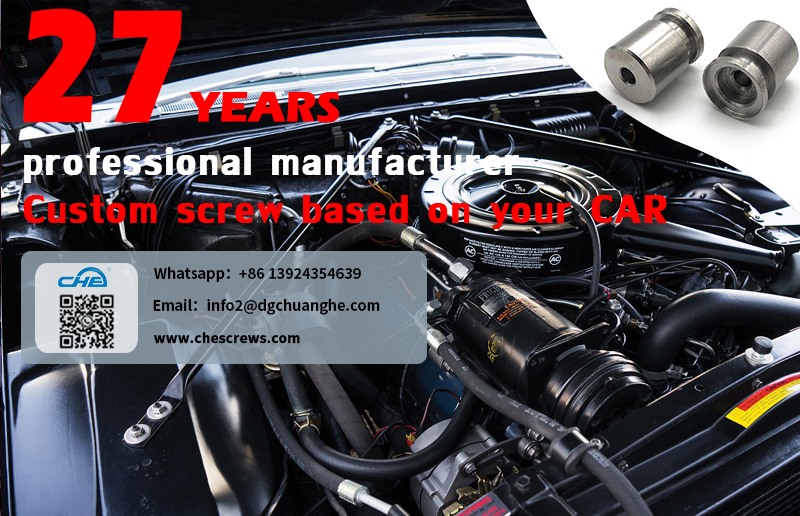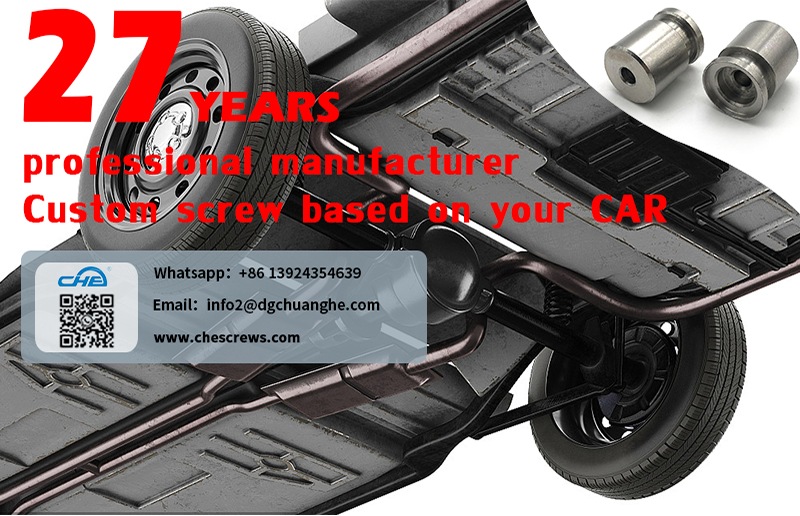The modern automotive engine is a masterpiece of engineering, comprising numerous components that work in harmony to generate the power needed to propel a vehicle. One often overlooked but crucial aspect of an engine’s construction is the use of fasteners. These small but vital components hold the engine together, ensuring its structural integrity and reliable performance. In this article, we will delve into the world of automotive engine fasteners, exploring their types, materials, importance, and the engineering advancements that have improved their durability and performance.

Types of Engine Fasteners
Bolts: Bolts are one of the most common types of fasteners used in automotive engines. They come in various sizes and are employed in connecting engine components, such as the cylinder head to the engine block, and securing vital parts like the crankshaft and camshaft.
Nuts: Nuts are typically used in conjunction with bolts to create a tight connection between two or more parts. They come in different shapes and designs, including hexagonal nuts, flange nuts, and lock nuts, each designed for specific applications in an engine.
Studs: Studs are long, threaded rods used to secure components in an engine. They are often employed in critical areas, like cylinder heads, to ensure even distribution of load and consistent torque.
Screws: Screws are used in various engine accessories, such as securing covers and electrical components. They are characterized by their threaded shaft and a head that allows for easy turning.
Washers: Washers are thin, flat discs used in combination with bolts and nuts to distribute loads and prevent damage to engine components. They come in various materials and designs, including flat washers, lock washers, and spring washers.
Materials Used in Engine Fasteners
The choice of material for engine fasteners is crucial to their performance as it determines their strength, durability, and resistance to various environmental factors. Some common materials used in automotive engine fasteners include:
Steel: Carbon steel is a popular choice due to its strength and affordability. Alloy steels are often used in high-performance engines because they offer enhanced tensile and yield strength.
Stainless Steel: Stainless steel fasteners are resistant to corrosion, making them suitable for use in areas where exposure to moisture and other corrosive elements is a concern.
Titanium: Titanium is exceptionally lightweight and corrosion-resistant. It is often used in high-performance and racing engines where weight reduction is critical.
Aluminum: Aluminum fasteners are lightweight and resistant to corrosion. They are commonly used in non-load-bearing applications, such as securing engine covers.
Brass: Brass fasteners are known for their corrosion resistance and aesthetic appeal. They are often used in decorative or low-stress applications in the engine.
Plastic: In certain non-structural and low-load applications, plastic fasteners can be a suitable choice due to their non-conductive properties and low weight.
Importance of Fasteners in Automotive Engines
Structural Integrity: Fasteners play a pivotal role in maintaining the structural integrity of an engine. They ensure that all components are securely held in place, preventing the engine from disintegrating under the stress of operation.
Leak Prevention: Properly tightened fasteners are essential for preventing fluid and gas leaks in an engine. This is particularly critical in the context of oil and coolant systems, where leaks can lead to engine overheating or damage.
Vibration Dampening: Engines generate significant vibrations during operation. Fasteners, such as locknuts and lock washers, are designed to absorb and mitigate these vibrations, preventing loosening over time.
Thermal Expansion: Automotive engines undergo extreme temperature variations. Fasteners need to accommodate the thermal expansion and contraction of various components, ensuring a consistent clamping force.
Load Distribution: Studs are often used in critical areas like cylinder heads to distribute the load evenly, minimizing stress concentration and preventing gasket failures
Advancements in Engine Fastener Technology
Automotive fastener technology has seen significant advancements over the years, driven by the need for engines to be more powerful, efficient, and reliable. Some notable advancements include:
Torque-to-Yield (TTY) Fasteners: TTY fasteners are designed to stretch slightly when tightened, providing a more precise and consistent clamping force. This technology is commonly used in critical engine components like cylinder head bolts.
Coatings: Many fasteners now feature specialized coatings to enhance their corrosion resistance and reduce friction during tightening. These coatings include zinc plating, cadmium plating, and various organic coatings.
ARP Fasteners: Automotive Racing Products (ARP) is a well-known manufacturer of high-performance engine fasteners. ARP fasteners are designed to meet the demanding requirements of racing engines and other high-performance applications.
Composite Fasteners: Lightweight composite materials are finding their way into automotive fastener design. These materials offer a balance between strength and weight reduction, particularly in racing and aerospace applications.
Computer-Aided Design (CAD): CAD software has revolutionized fastener design and engineering. It allows for the precise calculation of clamping forces, stress distribution, and thermal properties to ensure fasteners are optimized for their intended applications.
3D Printing: Additive manufacturing technologies, such as 3D printing, are being explored for the production of custom and complex fasteners, opening new possibilities in design and performance.
Maintenance and Replacement
Proper maintenance of engine fasteners is vital to ensure the continued reliability and performance of the engine. Here are some key considerations:
Torque Specifications: Follow the manufacturer’s recommended torque specifications for all fasteners. Over-tightening or under-tightening can lead to problems such as gasket failures or thread damage.
Regular Inspections: Periodic inspections of fasteners are essential to identify any loosening or damage. This is especially critical in high-stress areas like the cylinder head.
Replacement: When replacing fasteners, always use high-quality, OEM-approved components. Reusing old or damaged fasteners can lead to engine failures.
Lubrication: Proper lubrication of fasteners is essential to achieve the correct torque values during assembly. Lubricants specifically designed for fasteners should be used to avoid inaccuracies.
Conclusion
In the world of automotive engineering, the importance of fasteners cannot be overstated. These seemingly humble components are the glue that holds the engine together, ensuring its reliability, structural integrity, and performance. As engine designs continue to evolve and demands for higher efficiency and power increase, fastener technology will also progress, contributing to the ongoing advancement of automotive engineering.
From the choice of materials to the precision of torque specifications, every aspect of engine fasteners plays a vital role in the overall success of an automotive engine. As technology continues to advance, we can expect even more innovative solutions to further enhance the performance and durability of these essential components.






